"Wee" Bond and the "Fear of Flipping"
by Max Wawrzyniak
I have noticed a common thread running through the stories told by home boat builders; the fear of the dreaded hull flip; i.e. having to flip-over the hull at some point in the construction sequence. Now, hull flipp'n never has been something that I have been overly concerned with, and although my largest boat to date is only 18 feet in length, I doubt that I will ever get much concerned about flipping hulls of any length that I would consider constructing. They would all pall when compared to some of the really BIG boats that have been flipped, which brings me to my story.
The barge has been raisied up onto it's edge, and preparations are
underway on the "landing cushion."
(click images to enlarge)
|
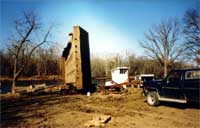 |
|
Wayne E. Bond liked to be called "Wee" Bond because of his initials, not because of his physical stature and definitely not because he shyed away from big projects of any sort. After returning from WW II service (with a horde of Nazi "souvenirs" such as daggers and swords that only he could have sneaked past the military inspectors) Wee Bond went to work on the St. Louis riverfront loading new automobiles onto barges. In the late '40s and early '50s, St. Louis had plants producing all three of the major auto brands (GM, Chrysler, & Ford.) Back in those days, it was common to ship autos aboard Mississippi River barges. This was before the advent of petroleum pipelines, and barges would carry crude oil and refined products from the Gulf Coast to the St. Louis-area refineries and terminals where the oil would be discharged. The empty barges would then have autos loaded upon their decks for shipment back South. Business was so good that a few special auto-carrying barges were built, resembling nothing so much as three-story-tall floating parking garages.
|
The underside of the barge, rusted thin and about to receive a
second layer of steel. Wee called this "replating;" others called it "over-plating," "doubling," or even "half-assed repair." |
|
It was Wee Bond's job to supervise the loading of these autos; they were pushed aboard the barges with Jeeps fitted with padded bumpers and were parked so close together that the people steering the new autos had to climb out of the windows, there being no room to open the doors. During slow periods in the auto loadings, Wee found time to gather together some scrap steel and build himself a little 28 foot towboat, as a Mississippi River-style "push" boat is called. The towboat was powered with a Chrysler Ace gasoline inboard engine purchased from the Standard Boat and Motor Company, a nearby business. Apparently Wee's bosses thought little of his pursuit of private interests on "company time" and Wee was left without employment.
|
View from the water; Wee's home-built 34-foot steel towboat just to the left of the barge. His home, which he built from two previously flood-damaged cabins, repaired and joined together, behind the towboat. |
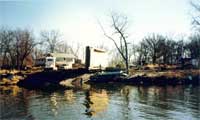 |
|
Somewhat disillusioned with employment by others, Wee moved himself and his wife and children to 3 acres of Mississippi River-front property in St. Charles County, North of St. Louis, where he went into business for himself, engaging in whatever work could be found and acquiring what equipment he could. It mattered little that he had no money and no help; somehow he always managed to complete whatever job he took on. He already had the little towboat, and soon acquired a barge to push, an 80 foot long, 19 foot wide steel barge. The barge was purchased cheaply "as-is, where-is." "As-is" was upside down; "where-is" was under about 30 feet of water. A self-taught hard-hat diver, Wee raised the sunken barge and then used it and the towboat to farm islands in the Mississippi River, filling in slack periods with such construction and demolition jobs as he could find. One such demolition job was the removal of a very large steel oil storage tank from a river terminal that wanted to construct a warehouse building on the site. Wee disassembled the tank in exchange for the steel from the tank. This provided him with sufficient steel plate for several decades-worth of projects, including the construction of a 34-foot towboat to replace the 28-footer which rusted-out after about 25 years of service. The new 34-footer was powered with a 165 hp model 6-71 Detroit diesel engine which came from a rotted WW II landing craft which Wee acquired in trade for a road grader. When he tried to start-up the long-idle engine, several of the fuel injectors "stuck." He boiled them in a pot of water on the kitchen stove and then soaked them in a can of diesel fuel and reinstalled them. The engine started right up and ran fine.
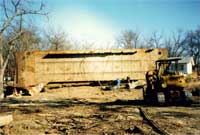 Wee seated on the ancient I.H. crawler and directing the securing of the cables from the crawler to the barge. His usual "throne," from the seat of the crawler he would direct the activities of his helpers. He had no full-time employees, but rather worked with a constantly changing collection of locals needing temporary employment. Wee had a knack for getting the job done even without the base of a knowledgeable, reliable work force. Wee seated on the ancient I.H. crawler and directing the securing of the cables from the crawler to the barge. His usual "throne," from the seat of the crawler he would direct the activities of his helpers. He had no full-time employees, but rather worked with a constantly changing collection of locals needing temporary employment. Wee had a knack for getting the job done even without the base of a knowledgeable, reliable work force.
|
|
Which brings us to "boat flipp'n." By the mid-80's the steel bottom on the old barge was rusted pretty thin and Wee drug it up onto the muddy river bank intending the flip it over and weld a second layer of steel over the rusty bottom. Now, a proper repair would have been to "crop" (remove) all of the thin plate and "renew" any wasted framing and then apply the new plate. This would have taken more time and materials than Wee had available, so he conspired to merely "double-over" the old bottom with some of the steel from the oil storage tank disassembly project, figuring such a 'fix" would outlast his need for the barge (which it did.)
|
The barge has just been given a little pull and over she comes. Note the 2-foot-tall walls along the deck. |
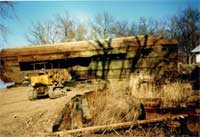 |
|
When I arrived at Wee's "shipyard," the barge had already been tilted up on to it's side, and there it stood, apparently somewhat precariously judging from the way Wee's helpers behaved when in the vicinity. This was obviously not an OSHA-sanctioned operation. Wee had decided to allow the barge to merely "fall-over" upside down and the helpers were stacking old truck tires next to the barge as a cushion for it's landing. Wee had an old International Harvester crawler-loader ("bulldozer" for those not knowledgeable in construction equipment) and cables were rigged from the upturned barge to the crawler, the plan being to give the barge a pull and let it fall on the tires.
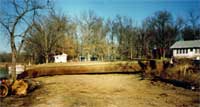 After the dust has settled. The deck of the over-turned barge is now just inches above the ground. Wee anticipated some damage, but calculated that repairing the damage would be less work than trying to gently lower the barge. Maybe one of the few times that this self-taught engineer miscalculated.
After the dust has settled. The deck of the over-turned barge is now just inches above the ground. Wee anticipated some damage, but calculated that repairing the damage would be less work than trying to gently lower the barge. Maybe one of the few times that this self-taught engineer miscalculated. |
|
When the last of the tires was placed, the helpers ran for cover as Wee cranked-up the crawler and "took-up" the slack in the cables. With one last look to ensure everyone was clear, Wee eased the crawler into gear and gave a bit of a pull on the cables and over came the barge, landing with a crash that shook the earth and raised clouds of dust that took several minutes to clear, revealing the now upside-down barge resting on stacks of tires compressed to about 6 inches thickness.
|
Placing the sheets of steel on the barge so that the welding can begin. |
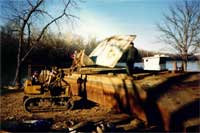 |
|
Now, that 6-inches of thickness was not what he had wanted to see, as there were 2-foot-tall walls along the deck of the barge, or rather there HAD been 2-foot-tall walls along the deck of the barge. The walls were now folded down to 6-inches, or had pushed the deck up into the hull about 1 1/2 feet. But that was damage that could be repaired, and Wee wasted no time in starting to move steel plate onto the hull to be welded into place.
|
A dreary day to begin the process of "righting" the now-repaired barge. The gin pole has been rigged for the turn-over. |
|
I found time to visit the "shipyard" on the day that the now-repaired barge was being rigged for the flip back to up-right. A gin pole had been rigged to flip the barge back up onto it's side. This was how the barge had initially been turned up on edge, with Wee's crawler pulling on the gin pole, but with an added layer of steel on the hull, the barge was now much heavier and required a second crawler to tilt it up, a need Wee had anticipated and so the borrowed second crawler was on site. The barge came back up onto it's side quickly and easily. I had to hit the road but was later told that Wee decided to re-rig the gin pole to allow the barge to be gently lowered to the upright position rather than to let it fall again. Afterwards, the damage to the decks was repaired and the barge placed back into service transporting farm equipment to the islands, a venture that lasted only a few more years before the government agencies involved became too difficult to live with for a man used to doing a job by whatever means it took to do it. Afterwards, the barge lay mostly idle while Wee concentrated on his business of jacking-up houses to get them above flood water level.
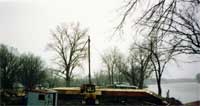 Securing the rusty old cables that were probably discarded by someone as being too fragile for continued use. Such was the equipment that Wee had available to work with. To my knowledge, he never had anyone seriously injured on his jobs, although I once managed to smash two fingernails helping him move some steel beams. |
|
Wee's method of raising houses utilized (2) long reinforced fabricated steel beams extending through (4) 16-foot-tall "jack stands," as he called them, which had movable bases for 20-ton hand-operated hydraulic jacks which could be "pinned" at various heights. The beams would be raised until the jacks were fully extended, at which point the beams would be temporarily "pinned" in place. The jacks would then be compressed, and the jack bases moved up to the next level and re-pinned, and jacking would resume. Utilizing this system, which Wee designed and which he built from the accumulated scrap steel laying around his "shipyard," he could raise a house 12 or 14 feet in just a couple of days, once the equipment was set-up. Building the new supporting foundation or structure to support the house at it's new level was a separate job which Wee would do or the home owner could do it himself, the house resting upon the stable base of the jack stands and beams while the construction was underway.
|
With an added layer of 1/2" thick steel on it's bottom, the now much heavier barge required (2) crawlers to bring it back up onto it's side. |
|
The house raising business began to fall off, however, when a local contractor purchased, at extreme cost, an engine-driven hydraulic system which allowed one person to control, from a central point, numerous power hydraulic jacks. This "high-tech" house raising apparatus could raise a house to it's new elevated position in just one day, but required a volume of jobs in order to justify it's high price that left little business for Wee. Now into his eighth decade, Wee was reduced to cutting-up the steel scrap which had accumulated around his property over the years and and hauling it to a scrap metal recycler on his ancient International Harvester flat bed truck. This scrap metal, now being sold for pennies per pound, had been the inventory for Wee's inspirations, the life blood of his creations. From the scrap had arisen his towboat, his repaired barge, the jackstands, and an untold number of other creations than enabled him to scratch-out a living on his 3-acres of riverfront mud.
|
Up she comes. |
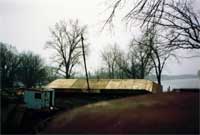 |
|
As with any entity feeding upon itself, it was obvious now that time was growing short. Somehow, Wee and his wife managed to get by on the scrap sales and a meager Social Security check. Meal time at Wee's could become an adventure, as one was usually not told exactly what one was eating until afterwards. One time a bowl of something that looked like, and tasted like, apple pie filling was identified as a recipe containing watermelon rinds. Another meal contained various parts of a racoon which had unwisely wandered within rifle range of Wee's front door. Yet another entree was subsequently identified as "pig nuts:" I will spare those squeamish readers further description.
Wee has been gone for almost a decade now. The towboat and barge were sold to a contractor over on the Illinois River and may still be in service, for all I know. The "shipyard" property was sold to an adjacent marina and is in the process of being "gentrified" to better suit the tastes of weekend pleasure boaters.
|
Up on it's side (but not very stable) the barge shows it's new layer of steel. "Dashed" lines are "plug welds" which secure the centers of the large plates to the original bottom underneath. |
|
I don't "get out that way" much anymore but when I do I usually run across someone with a "Wee Bond" story to tell, about how he did this or he did that when no one else thought it could be done, or could not be done without more equipment or more men or more money than Wee got it done with.
And flipp'n-over plywood boats is a task which doesn't much phase me; I have yet to see one shake the ground the way that steel barge did.

